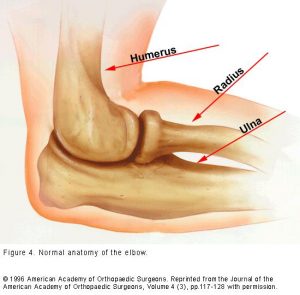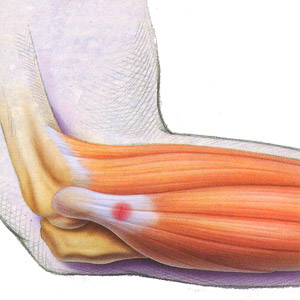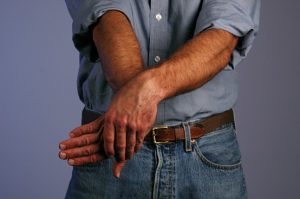 The elbow is a complex joint that is often asked to perform repetitive tasks under significant stress. The elbow is made up of the distal end of the humerus and the proximal ends of the ulna and radius. Muscles that cross the elbow allow us to flex and bend the elbow as well as perform many of the motions of our hands. This includes flexion and extension and the turning motion of the wrist and hand.
The elbow is a complex joint that is often asked to perform repetitive tasks under significant stress. The elbow is made up of the distal end of the humerus and the proximal ends of the ulna and radius. Muscles that cross the elbow allow us to flex and bend the elbow as well as perform many of the motions of our hands. This includes flexion and extension and the turning motion of the wrist and hand.
If pain is located along the inside of the elbow, this is often due to medial epicondylitis. Pain along the lateral aspect of the elbow is most commonly lateral epicondylitis. Pain with swelling in the back of the elbow may be due to olecrenon bursitis. People that perform a throwing motion are vulnerable to a host of sport-specific elbow injuries that must be evaluated carefully. Children and adolescents are especially vulnerable secondary to the fact that they are growing and have open growth plates.
What is lateral epicondylitis?
Lateral epicondylitis is also referred to as “tennis elbow.” This condition occurs in response to cumulative trauma and injury to the tendon that attaches to the muscles of the forearm, specifically, the origin of the extensor carpi radialis brevis muscle. Pain on the outside of the elbow, normally during or after intense use, usually indicates lateral epicondylitis. In some cases, lifting, grasping, and even light use may be difficult or painful. Because people who play tennis or other racquet sports sometimes develop this problem it has become known as “tennis elbow.”

What causes lateral epicondylitis?
Overuse of the wrist extensors (muscles that pull the hand up) can create cumulative stress on the tendons that attach to the elbow at the outer part (the lateral epicondyle). This excessive stress may damage the muscle attachment and cause inflammation and pain. Generally, those who experience lateral epicondylitis perform activities with motion of the wrist and arm, or lifting while the palm is facing down. The condition is quite common in a person’s late 30’s and early 40’s.
 In racquet sports, intense gripping can lead to tennis elbow. It appears to be caused by a lack of strength, inefficient technique, improper equipment, or increasing playing time and intensity too quickly. In tennis, a common cause is a racquet’s inappropriate string tension and grip circumference.
In racquet sports, intense gripping can lead to tennis elbow. It appears to be caused by a lack of strength, inefficient technique, improper equipment, or increasing playing time and intensity too quickly. In tennis, a common cause is a racquet’s inappropriate string tension and grip circumference.
Rarely, the inflammation comes without any definite cause, and this may be due to arthritis, rheumatism, or gout. Sometimes the problem is partly or completely due to a neck problem, which is causing pain in the elbow via the nerves from the neck.
The area of most pain is usually near the bone on the outer side of the elbow known as the lateral epicondyle. The area is usually tender when touched and may be uncomfortable when gripping. In severe cases, almost any movement can be uncomfortable.
What is the treatment for lateral epicondylitis?
Discontinuing activities that cause the pain is the first step toward proper treatment of lateral epicondylitis. Icing the elbow 10-15 minutes at a time will decrease the inflammation and swelling and relieve pain. A tennis elbow strap can often improve symptoms by dampening the vibration along the extensor tendons. Anti-inflammatory medication may help reduce inflammation and pain. In chronic or intense cases, a steroid injection may relieve the discomfort.
 Exercises that stretch and strengthen the muscles will help prevent the condition from returning. The goal is to place the extensor tendons on a slow, controlled stretch (see below). This allows the tendons to regain their normal length. Recurrence of this condition is common, and therefore, return to activity should not occur too quickly.
Exercises that stretch and strengthen the muscles will help prevent the condition from returning. The goal is to place the extensor tendons on a slow, controlled stretch (see below). This allows the tendons to regain their normal length. Recurrence of this condition is common, and therefore, return to activity should not occur too quickly.
If nonsurgical forms of treatment do not eliminate the pain of this condition, surgery may be recommended. Surgery consists of a mini-open debridement of the insertion of the extensor carpi radialis brevis tendon. Lateral epicondylitis is often a nagging or chronic condition sometimes requiring many months for healing to occur.
